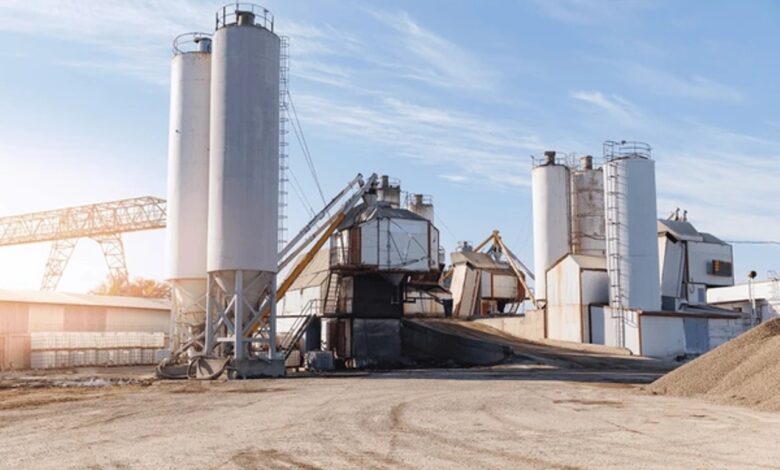Driving Efficiency and Innovation: Business Tips for Cement Manufacturing Success

Cement manufacturing industry, the most famous industry, is a powerhouse of global construction and infrastructure. This industry provides essential materials for various projects worldwide.
It is a big industry that makes over 4 billion tons of cement annually, which is about 70% of all construction materials used globally. This industry is valued at $450 billion. Hence, it significantly impacts the global economy and supports millions of jobs.
However, despite rapid urbanisation and large-scale construction projects, manufacturers often struggle with profitability due to the capital-intensive nature, energy-consumption, and environmental impacts.
Read More: Maximizing Efficiency: The Growing Importance of Software Integration in Business Operations
With growing demand and new challenges, cement plant manufacturers need to find ways to work more efficiently and innovate.
In this article, we will discuss on some practical tips and strategies to help your cement businesses succeed. By using, these strategies you can stay competitive and thrive in today’s fast-changing market.
Business Tips for Cement Manufacturing Success
Effective business planning and budgeting are absolutely crucial for running a successful cement manufacturing business. Why? Well, the market can be unpredictable. Sometimes, demand can suddenly spike or drop, raw material prices fluctuate, and new regulations pop up. All of this makes it hard to maintain a balance. To keep things steady, you have to:
1. Plan production carefully
Produce only the right amount of cement. If the production is too much, you’ll have to face costly storage issues. And if it is too little, then you won’t be using your resources efficiently.
Hence, to plan your production well, you need to stay in tune with market trends. These include:
- Rising urbanisation
- New government projects
- Increased demand for housing.
This will help you to understand how much cement will be needed in the future. And hence you can plan ahead. This way, you can save your business from overproducing, expensive storage, and underproducing.
2. Strategic Budget Allocation
Cement production requires a big amount of investments. You need to buy as well as maintain machines to source raw materials and handle transportation. Therefore, it is necessary to allocate your budget.
Also don’t forget to reserve funds. Because sometimes demand can suddenly increase or drop, so you may face a shortage of raw materials. By Having extra funds, you can handle these unexpected changes without risking financial trouble.
3. Cost Optimization
In the cement industry, profitability can be tight because the margins are not very big. Hence, controlling costs is the most important thing to stay competitive in this industry. To do this, you can:
Raw Material Sourcing
Cement production depends heavily on materials like limestone, clay, and other materials. But these materials are expensive, and also they are not always sustainable. To cut costs you can go with alternative materials, like
- Fly ash
- Blast furnace slag
- Other industrial by-products.
These products are sustainable cement blends that will help cut down on emissions as well as reduce material expenditure. This way, your industry can support sustainability by reducing carbon footprint efforts as you can reuse waste that would otherwise be discarded.
Power and Energy Optimization
Cement manufacturing is an energy-consuming process. There are around 30-40% of the total production costs go toward energy. To cut down on this, you can can go with energy-efficient technologies like
- Preheating,
- Precalcining
- Advanced burner designs
- Shifting to alternative fuel sources like:
- waste-derived fuels
- Natural gas
- Biomass
You can also use energy management systems to monitor real-time energy consumption. This will help you to identify where energy is being wasted and helps you optimise usage.
Furthermore, here are some things you should focus on:
- Process optimization: Streamline your production process to reduce energy usage.
- Energy audits: Regularly check for inefficiencies.
- Alternative fuels: Use lower-cost fuels to cut down on energy bills.
- Heat recovery: Reuse the heat generated during production.
Freight and Distribution Management
Transporting raw materials to your plant can be expensive. It can take up about 20% of your total production costs. So, find closer places from your plant to get materials, you can save a lot of money on transportation.
At the same time, transporting cement is expensive as it is bulky and requires huge space. Hence, to save cost, you can use:
- Route optimization tools to find the fastest and cheapest routes
- Outsource logistics to third-party providers
- Use different modes of transportation, like rail and road
By doing these things, cement manufacturers will save on their costs as well as make their operations more sustainable and efficient. This will ultimately help them to make more profit in the long run.
Read More: Safeguarding Your Business: The Importance of SBA Surety Bond Guarantee Program
4. Invest in Technological Innovation
Technological advancements are rapidly transforming industries worldwide, and cement manufacturing is no exception. If you want to stay competitive, you’ve got to be on top of the latest tech.
Industry 4.0 Integration
Use advanced digital technologies to make things run better and smarter. You must use technologies like:
- IoT: Real-time operation monitoring
- AI: Predictive maintenance
- Big data: Improve processes and reduce waste.
These technologies make cement manufacturing processes more efficient. It also increases productivity by 15-25% and reduces costs by 20-30%.
Automation and Robotics
In today’s world, robots can help to make our work easier and faster. By using robots in production, you can enhance production speed and accuracy. Robots can handle repetitive task like packaging or logistics. They can work faster and without any breaks. They enable your human workers to give more time to focus on important things like improving processes or fixing problems.
Digital Twins
A digital twin is like having a virtual copy of something real, whether it’s a machine, a process, or an entire system. Imagine it as a digital version of your factory or equipment. You can use this virtual version to try out new ideas, run tests, and even spot issues before they happen. The best part? You can do all of this without touching your actual equipment, so there’s no risk of interrupting or messing up real production.
5. Employ Sustainable Practices
Cement production is responsible for CO2 emissions. This is one of the main gases causing climate change. Around 7-8% globally, and that’s why it is important to find ways to make the process more environmentally friendly.
Many big companies are now developing eco-friendly products like green cement. This type of cement helps reduce CO2 emissions, which is better for the environment. Builders and governments are increasingly choosing these options as it reduces the overall impact on the planet.
Below we have shared some ways to make your cement manufacturing process more sustainable:
- Waste heat recovery systems: Capture and reuse heat, reducing electricity consumption.
- Use alternative fuels: Instead of using traditional fuels, companies use fuels that are made from plants and organic waste. This can reduce up to 30℅ harmful emissions.
- Renewable energy: Use solar or wind power instead of fossil fuels like coal and gas.
- Sustainable cement blends: blend traditional cement with more eco-friendly materials
Do you know? Birla Cement are investing in large-scale green initiatives, like rainwater harvesting and planting trees. This enhance sustainability as well as attract customers who care about the environment.
Hence, it is very important to follow global environmental rules and regulatory requirements. If not, you might lose out to competitors who are contributing to protect the environment. In short, going green helps both the planet and the business.
6. Continuous Improvement
To succeed, you should always find ways to improve your operations. This includes:
Lean Manufacturing Principles
It will eliminate waste, improving workflows, and maximising value. It use methods like Kaizen for ontinuous improvement) or Six Sigma for to reduce defects. By using these strategies, companies can improve their productivity and save money. In fact, Some businesses have already increased their efficiency by 30% just by adopting these methods.
Employee Training and Development:
Your employees are really important to your business. Hence, train them regularly on new technologies, safety rules, and industry trends. This way, you keep them up-to-date with the latest advancements and motivated. Well-trained employees can quickly find opportunities for improvement.
Encourage Cross-Departmental Collaboration
Encouraging collaboration between different departments like research and development (R&D), production, and supply chain management promote innovation. Cross-functional teams can develop new ideas and solutions to address challenges more effectively.
7. Prioritise Workplace Safety
Make sure that your employees work in a safe environment. It is very important for their health and for your company as well for operational continuity.
AI-Powered Safety Systems
These AI-driven safety technologies monitor the workplace in real-time and predict possible dangers. This way, if something risky might happen, workers get alerted before an accident occurs.
Fostering a Safety Culture:
Establish a culture of safety in everyone. You should regularly train your employees and update their safety rules. If safety becomes a top priority, there will be fewer accidents, everyone will follow safety regulations better, and the workplace will be healthier overall.
8. Leverage Data and Analytics
Data-driven decision-making is becoming really important nowadays for every manufacturing, including cement manufacturers. Here’s how it helps:
Improve Production through Data Analytics
By collecting and analysing data from the production processes, you can find where things are not working as efficiently as they should. And from this data you can take corrective actions. This data can provide insights into areas such as raw material usage, energy consumption, and machine performance.
Customer Insights and Market Trends
Data analytics can also help businesses understand customers preferences and spot trends in the market. This way, upi can tailor your products and services to meet those needs, staying ahead of the competition.
Forecasting and Planning
Accurate forecasting enables better planning of production schedules and resource allocation. By using past data and advanced analytics, businesses can make more informed decisions and reduce costly mistakes.
Read More: How to Start a Wholesale Distribution Business in 2024?
9. Enhance Product Innovation
While cement has been around for a long time, there’s still room to innovate and create new versions of it. If companies focus on improving their products, they can stand out from the competition. To do this, you can:
Develop Specialty Cements
These are cements designed for specific purposes, like curing faster, being stronger, or lower carbon emission. Different industries often need cement with unique properties, and by creating products tailored to those needs, businesses can attract more customers
Sustainable Cement Products
As we talked about earlier, the need for sustainable building materials is growing fast. To keep up, cement companies can focus on creating more eco-friendly products. One way to do this is by using recycled materials or cutting down on clinker (which is a key part of cement but produces a lot of carbon emissions). By reducing clinker or using alternatives, companies can offer greener options that are better for the environment.
Collaborate with Research Institutions
By working with institutions or research centres, companies can stay ahead of the curve and come up with new technologies or materials that improve the performance of their products. So we suggest you invest at least 10-15% of your annual budget into researching new technologies for big advancements.
10. Focus on Customer Satisfaction
Last, but very important thing, customer satisfaction. This is a very important factor for success. Cement manufacturers should focus on customers’ requirements and offer high-quality products.
Offer great support:
Think about after-sales support like you would with any service—if you run into a problem, you want someone there to help, right? Cement companies can boost customer loyalty by offering solid technical support and making sure deliveries happen on time. When customers feel taken care of, they will surely come back to your services and even recommend the company to others.
Customisation:
Not every construction project is the same. Some customers need special solutions, and when a cement plant & machinery manufacturing company can meet those unique needs, it builds a much stronger relationship with the customer.
Listen and improve:
Gathering feedback from customers is key. It’s like asking them, “What can we do better?” and then actually making those improvements. When customers see that a company is willing to listen and change, it can really improve their overall experience.
Conclusion
To succeed in cement manufacturing, companies need to focus on three main things: improving how they operate, using eco-friendly methods, and adopting new technology. By using energy-saving tools, finding better materials, and constantly looking for new ways to improve, cement plant manufacturing companies can work more efficiently, save money, and keep up with what customers want. Following these strategies helps them stay ahead of the competition, make a profit, and contribute to a greener, more sustainable future.











